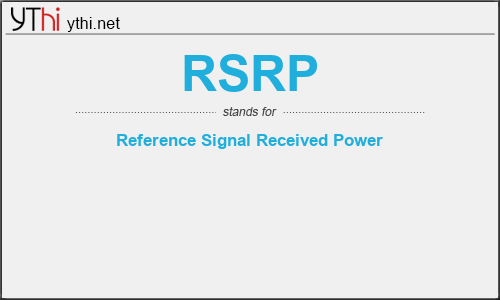What does RSRP mean? What is the full form of RSRP?
The Full Form of RSRP is Reference Signal Received Power.
RSRP and RSRQ are key measures of signal level and quality for modern LTE networks. In cellular networks, when a mobile moves from cell to cell and performs cell selection/reselection and handover, it has to measure the signal strength/quality of the neighbor cells.
In LTE network, a UE measures two parameters on reference signal: RSRP (Reference Signal Received Power) and RSRQ (Reference Signal Received Quality).
In LTE network, a UE measures two parameters on reference signal:
RSSI – Received Signal Strength Indicator:The carrier RSSI (Receive Strength Signal Indicator) measures the average total received power observed only in OFDM symbols containing reference symbols for antenna port 0 (i.e., OFDM symbol 0 & 4 in a slot) in the measurement bandwidth over N resource blocks.
The total received power of the carrier RSSI includes the power from co-channel serving & non-serving cells, adjacent channel interference, thermal noise, etc. Total measured over 12-subcarriers including RS from Serving Cell, Traffic in the Serving Cell
RSRP – Reference Signal Received Power: RSRP is a RSSI type of measurement, as follows there are some definition of it and some details as well.
It is the power of the LTE Reference Signals spread over the full bandwidth and narrowband.
A minimum of -20 dB SINR (of the S-Synch channel) is needed to detect RSRP/RSRQ
RSRQ – Reference Signal Received Quality: Quality considering also RSSI and the number of used Resource Blocks (N) RSRQ = (N * RSRP) / RSSI measured over the same bandwidth. RSRQ is a C/I type of measurement and it indicates the quality of the received reference signal. The RSRQ measurement provides additional information when RSRP is not sufficient to make a reliable handover or cell reselection decision.
In the procedure of handover, the LTE specification provides the flexibility of using RSRP, RSRQ, or both.
It must to be measured over the same bandwidth:
- Narrowband N = 62 Sub Carriers (6 Resource Blocks)
- Wideband N = full bandwidth (up to 100 Resource Blocks / 20 MHz)
RSRP
means
Reference Signal Received Power![]()
Translate Reference Signal Received Power to other language.


Leave a Reply
You must be logged in to post a comment.